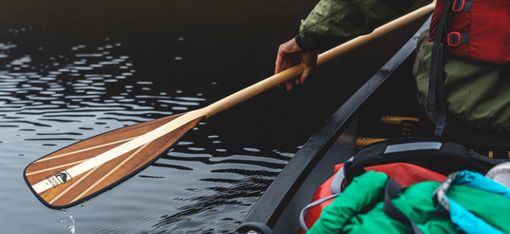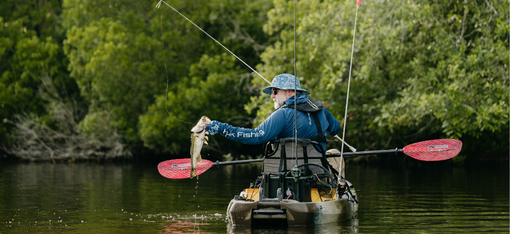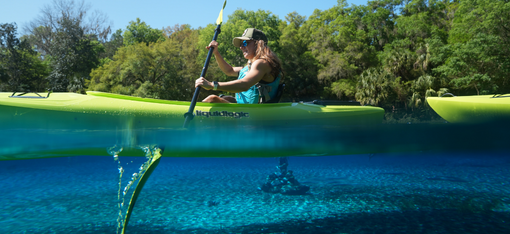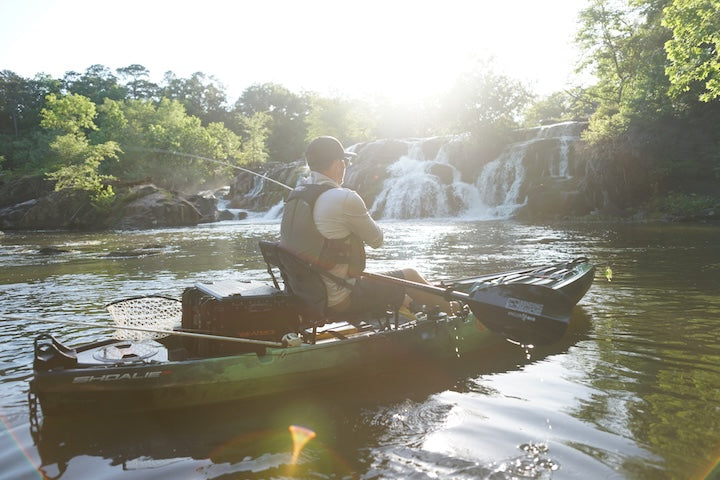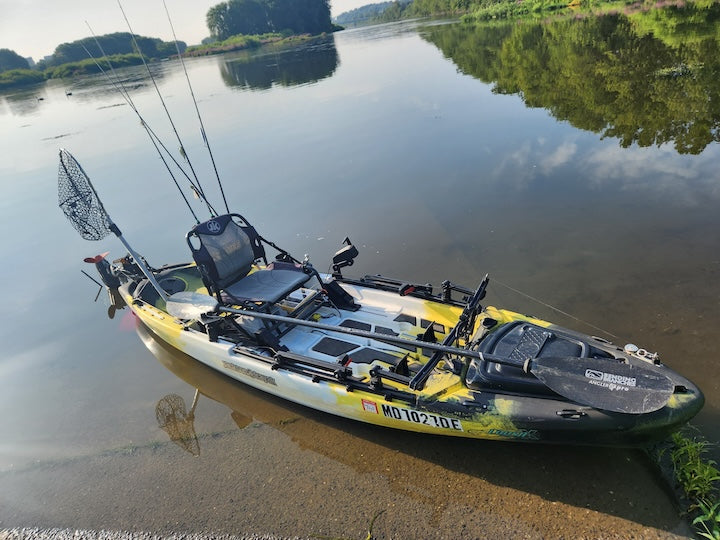How to Size & Choose a Canoe Paddle
- Paddle Length
- Features to Look For
- Bent vs Straight Shaft
- Grip
- Blade Shape
- Materials
- Solo Canoe Paddles
There's a lot of technical aspects to choosing the right canoe paddle. Our rule of thumb is for:
- 6 hour trips or less: Economical options are perfectly fine and added features are less necessary.
- 6 hours+/days or longer: All about weight and/or durability and performance.
Which paddle length is right for me?
There are many subtleties (and opinions) regarding how to determine the best paddle length. Many experienced paddlers have a collection of different paddle models and sizes for different conditions, but most people find the following chart to be effective in sizing new paddlers. The general rule: the shortest paddle that allows you to properly reach the water is best. In the middle of their stroke, most paddlers hold the grip so that their top hand is about the height of their nose, and the point where the paddle blade meets the shaft (the throat or shoulder) is at the water line.
Measure your Torso:
Measuring the length of your torso is a good way to approximate that geometry. Here’s a simple and accurate way to measure your torso. Sit up straight – don’t slouch – on a flat chair. Measure the distance from the surface of the chair between your legs to your nose. Then follow the chart below:
Quick Measuring:
An easy way to measure in the field is to place the grip of the paddle between your legs while sitting. Mark where the shoulder of the blade hits you. The shoulder on a straight shaft should be at your forehead; the shoulder on a bent shaft should be at your nose.
Canoe Style Notes:
- If you have a general-purpose, family tandem canoe, your selection process can be streamlined. You’ll want to look at the sizing chart below to make your paddle selections.
- For narrow tripping canoes, those with tumblehome (inward leaning) gunwales, or low seats, select a paddle with a shorter shaft (typically by one size).
- Extra-wide, flared canoes and those with high seats require a slightly longer paddle so that you can easily reach the water with the blade and avoid hitting the shaft (or your knuckles) on the gunwale.
What features should I look for in a paddle?
- Laminated wood shafts are generally both stronger and stiffer than solid wood.
- Blades with fiberglass resist splitting if they get caught between sharp rocks or piled under duffel bags in the back of your vehicle.
- Particularly with wood, smoothness of the finish is critical for your comfort.
- Some manufacturers offer high-grade resins along the entire edge of the paddle blade as well as on just the tip. If your paddle sees rough treatment or will be continuously exposed to water on a long trip, you’ll want this type of protection.
- Spar varnish is recommended by some paddle manufacturers for continuous exposure to sunlight, but that gives a softer finish that can pick up fine grit and feel tacky. Polyurethane provides a harder and more durable finish.
How do I know if I need a bent or straight shaft paddle?
Summary: Straight shafts are best for all around paddling and maneuvering strokes. Bent shafts are more efficient and ideal for long-distance trips.

Straight Shaft
Straight shaft paddles are flat on both sides of the paddle face, which this allows for greater control and canoe maneuverability. This is best for technical waters like narrow rivers or whitewater, and/or for all around paddling versatility since it does not matter which way the blade should face. Typically, solo paddlers or those who sit in the stern (back of the canoe) prefer a straight shaft, as they are considered the steering wheel for the canoe.
Bent Shaft
Bent Shaft paddles are built for efficiency and power. The angle of the blade allows the blade to remain vertical in the water for the most powerful part of the stroke, so you will use less energy propelling the canoe. At Bending Branches, we design our shafts with an 11-degree bend. Bent paddles are ideal for flatwater cruising, long distance expeditions, and racing. Typically bow paddlers or those who sit in the front of the canoe prefer a bent shaft since they do less steering.
Why is the grip shaped like that?
Summary: Most paddles have a palm grip for overall comfort and function; the T-grip is designed for extra control.

Palm Grip
The palm grip is designed by our engineers to fit the palm of your hand. This makes it a very comfortable grip and good for long trips. Typically, straight shaft paddles have a symmetric grip which is also called a Freestyle Palm Grip. This allows the paddle to be used on either side, making the back and forth switch less strenuous. Since bent shafts can only be used one direction, they typically have an asymmetric grip or what is known as the classic palm grip.
T-grip
Canoeists can wrap their fingers around the handle for control with a T-grip. Pushing your thumb against the outside end of the grip when maneuvering allows you to apply leverage to rotate and pry the canoe, and more easily manipulate the direction. The T-grip is only available on the Expedition Plus designed specifically for whitewater and expeditionary trips. If you're looking for a smoothed out version of the T-grip, the Sunburst has a T-grip blend meant to give paddlers the control leverage elements but without the sharp angles.
What is the difference between blade shapes?
Sugar Island is more common due to maximum efficiency in propulsion; Beavertail shape is ideal for deep water/rivers.
Sugar Island
Most all blade shapes within our line-up are the Sugar Island profile, meaning they’re a slight combination of a tear drop shape combined with element of square tipped. Other models like the Expedition or Arrow are more influenced by the square tipped designed. These designs are ideal for the large majority of flatwater canoeists as the entry and exit it smooth, quiet, and efficient. As well the profile is designed for maximum efficiency so every square inch/centimeter is used in propulsion.
Beavertail
The long and slender blades on the Beavertail profile allow for easy maneuverability which is ideal for solo canoes. They offer lots of control and provide an enjoyable entry/exit, but are annoying to paddle with in shallow conditions and susceptible to breakage there. Beavertail paddles are good for deep water/lakes as opposed to shorter, wider blades that are best for shallow water/rivers. Something to consider is that larger blade surface means more power and a smaller blade surface means less wind resistance so therefore a less fatiguing stroke.
Materials: Durability vs Weight
Summary: If you’re rough on your gear, opt for a fiberglass wrap and more Rockgard® coverage.
Blade Material 
Many people prefer the traditional look and feel of a wood canoe paddle. Wood is also a buoyant material, flexible and warm on the hands. At Bending Branches, all of our wood is locally sourced from the Midwest. Darker woods are going to be more dense, durable, and rigid in terms of flex, but also more expensive and much heavier. Lighter woods are more about function, value, and weight, hence their use in solid shafts. Generally speaking, more pieces of wood means more glue, and that translates into more durability.
For canoeists looking for a lightweight paddle for long trips or racing, carbon fiber may be a good option. Foam core composite material like in the Black Pearl II are the highest performing: stiff/no flex, durable, and lightweight. For the best of both worlds, we have the Sunburst paddle featuring a handcrafted wood blade and combination palm/t-grip with a carbon shaft to save weight. As the weight goes down in paddles, the price usually goes up as those materials are more expensive to procure.
Rockgard® Edge Protection Rockgard® is our proprietary technology. It is derived from the same material as inline skate wheels and maintains the integrity of the paddle, seals against moisture and protects the most vulnerable areas - the tips and edges. It is this unmatched shock-absorption that Rockgard® provides which helps our wood paddles last six times longer than those without protection.
Rockgard® is our proprietary technology. It is derived from the same material as inline skate wheels and maintains the integrity of the paddle, seals against moisture and protects the most vulnerable areas - the tips and edges. It is this unmatched shock-absorption that Rockgard® provides which helps our wood paddles last six times longer than those without protection.
Paddles with more Rockgard® offer extra protection from rocks and other elements. Our paddles are available in four levels of Rockgard® protection: tip, partial, full, extended.
Fiberglass vs. Non-glassed Blades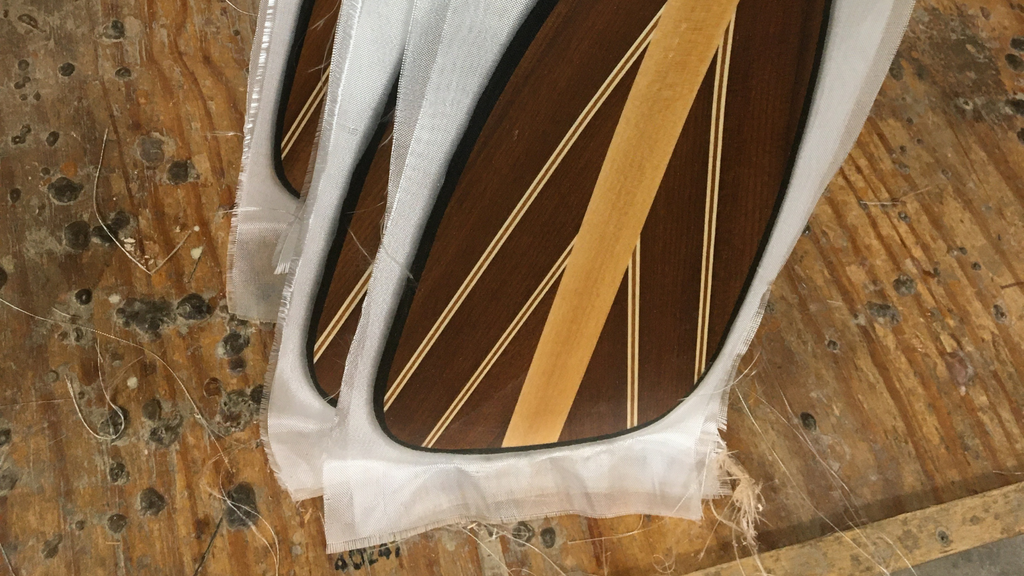
We also use a fiberglass wrap on most of our wood paddles. It protects the entire blade from dents and scratches, and seals in the wood’s glue so it’s less likely to separate at the joints, which means your paddle will require less refinishing.
The fiberglass does add some weight. If you’re rough on your gear, you’ll want to opt for the 4-ounce fiberglass wrap. If light weight is your top concern go for the 2-ounce wrap. You’ll still get plenty of durability.
Solo Canoe Paddles
In general, we recommend the same size paddle for tandem and solo canoes. So if your torso is 32", then your straight shaft size would be on average 58" regardless of if you're in the stern/bow of a tandem or in the middle, paddling solo or on your knees.
- When to size longer… if you're paddling in narrow creeks/rivers or whitewater, as well if you do more maneuverability strokes in the boat.
- When to size shorter…if the canoe is a tumblehome and/or sleek/narrow.
- For double bladed canoe paddles… use the chart below.




